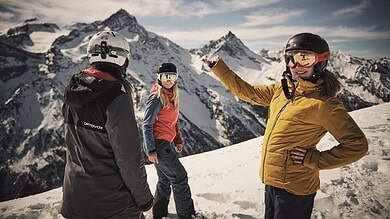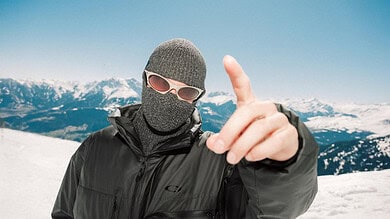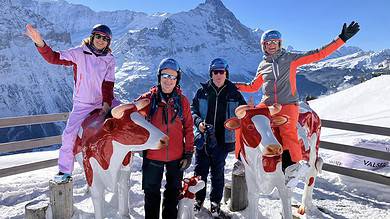
Red Bull athlete Alexis Pinturault (France), 34, has 34 World Cup victories, six Crystal Globes, eight World Championship medals, and three podium finishes at the biggest global competition. In a new interview with The Red Bulletin Magazine, Pinturault reflects on the defining moments of his career, his recovery from injury, and his renewed focus on the discipline that built his legacy – the giant slalom.
A Reign in Alpine Skiing
The Red Bulletin: If you had to sum up your career so far, what would be the most significant titles?
Alexis Pinturault: “Among the most important, there are the overall Crystal Globe and the year 2021. My World Champion titles, and my three most beautiful medals, even if there’s no gold!”
Versatility
The Red Bulletin: You have done all the alpine disciplines; how do you prepare yourself to handle these opposing efforts?
Pinturault: “We prepare for the core elements, meaning strength and power – especially power, which is developed through weight training. The other core element is endurance work, which allows you to withstand the entire winter, particularly the complexity and fatigue that come with it. So, having a good immune system that can recover well and function properly throughout the season is important. More specifically, as a giant slalom specialist, we focus more on explosiveness than on pure strength, unlike a downhill racer. My best results are in the technical disciplines, so we have focused more on these qualities of explosiveness.”
The Red Bulletin: In your opinion, which discipline is the most demanding?
Pinturault: “Those are all demanding, but each has its own particularities. In slalom and giant slalom, you work on your breathing. With the short turns, the muscles get less fatigued, but you still produce lactic acid, whereas in downhill, it’s more about pure strength, with lactic acid building up mainly in the legs and breathing being less affected. It’s really the course layout that makes the difference.”
Giant Slalom
The Red Bulletin: How do you go from being versatile to focusing on just one discipline?
Pinturault: “It was somehow forced by nature. I got injured back-to-back over the last two years, in 2024 and 2025. Even though the second injury was less serious than the first (after landing a jump in the super-G at Wengen in Switzerland, the skier from Courchevel tore the anterior cruciate ligament in his left knee – editor’s note), it kept me away from the circuit for four months. That’s what pushed me to refocus on my strongest discipline, to make the most of this relatively short time, to use it as best as possible to regain my performance level, with the goal of the big event in February.”
The Come-Back (from Injury)
The Red Bulletin: Coming back from injury, what does that mean for your preparation?
Pinturault: “During a normal season, we’re on vacation in May for a month. When we start the season again, we’re back at 80 per cent of our full potential. When coming back from injury, sometimes you start from zero. After my first injury, I was at 60 per cent of my abilities; after the second, I’d say a bit more, but still far from 100 per cent. First, you must go through a rehabilitation protocol to rebuild yourself: [that means] starting to walk again, then to run, which takes six to seven months. When you get back to skiing, you’re coming from far away…”
The Red Bulletin: What does that mean, concretely?
Pinturault: “You must recreate an athlete. The basics are tedious, but where it changes is when the competition season starts, because instead of racing two or three times a week, I’ll only be able to do one race a week, or even one every two weeks. That will give me time to improve and catch up with the famous train that’s always moving forward, which I must catch, and rest to avoid inflammation. The 20 per cent I’m going to look for is less about physical ability and more about technique, commitment, and taking risks. When you come back from injury, you’re even more focused on yourself than usual.”
Physical and Mental Qualities
The Red Bulletin: Can you list your greatest strengths?
Pinturault: “My explosiveness, which allows me to take more direct and sharper trajectories thanks to more powerful footwork in a shorter amount of time, my mental strength, and my tenacity. The mental aspect is hard to quantify; when the technique and physical abilities are there, the mental follows, but it’s an extremely important trio, almost inseparable. You could assign a third to each.”
The Red Bulletin: Can we also talk about weaknesses, what you’re working on in particular?
Pinturault: “I’m going to need to work on taking increasingly direct trajectories, which goes hand in hand with confidence, technique, and physical ability. Right now, I’m putting things in place to catch up with the pack and then get to the front car!”
The Red Bulletin: Let’s go back to the mental aspect. How do you condition it?
Pinturault: “I’ve had several mental coaches, even psychologists – it depends on the period and what you need to work on. It could be sophrology, visualisation exercises, or concentration exercises. It could be post-injury work: when you get injured like I did at over 100 km/h, the impact is very violent and it leaves marks, like a car accident without the car body. You also must accept reliving it by exposing yourself again to very high speeds.”
Motivation
The Red Bulletin: You’ve experienced everything in terms of achievements and career. How do you bounce back? What’s your fuel?
Pinturault: “The first is the pleasure I find in skiing; the second is the pursuit of performance. You have to be comfortable with your choices. Even though I sometimes have fun during training, the pleasure is greater in competition, with that heightened adrenaline. When you manage to combine performance, stress, and that state of flow (the ultimate performance), that’s when you get the most sensations and pleasure.”
The Red Bulletin: This pleasure, when does it manifest itself exactly? On the podium, at the finish line?
Pinturault: “The podium is a moment of reflection, a time to share with loved ones, to savour, to remember what you’ve been through. But the most powerful moment for me is when I cross the finish line and see the result: that’s the peak of the adrenaline rush. What state of mind are you in as the big event approaches? Eager for the season to start, to measure myself against the other competitors. Aware of the work I still have to do.”
Outside of Skiing
The Red Bulletin: How do you spend your free time?
Pinturault: “With family, training, competitions, and major events coming up, there’s less and less time, but I still do quite a few sports: tennis, padel, wakeboarding, and golf. In this region, we’re lucky to have such great playgrounds!”
Alexis Pinturault’s Fitness Routine
Pinturault: “What I do the most is stretches, mobility exercises, and Pilates. That’s every day. Strength training, I do more sporadically, two to three times a week and less during the winter. All the endurance work happens in the summer with 17 weeks of strength training, cycling, running, upper body work, proprioception, and footwork. As major events approach, there’s a rest phase to recharge, with shorter but high-intensity sessions to ‘build up energy.’”
Key Facts
- Athlete: Alexis Pinturault (France, 34) – Red Bull athlete
- Disciplines: Giant Slalom, Slalom, Super-G
- Career Victories & Titles: 34 World Cup wins, Crystal Globes, 8 World Championship medals, 3 medals at the biggest global competition
- Active Seasons: On the World Cup circuit since 2009
- Injury Timeline: ACL tear (left knee) during Wengen super-G, 2024
- Return Timeline: 4 months from injury to competition
- Training Volume: 17-week summer strength and endurance block
- Interview Source: The Red Bulletin Magazine
Why It Matters
Alexis Pinturault’s continued pursuit of performance after two major injuries reflects resilience and precision at the highest level of alpine sport. His focus on explosiveness and technical mastery exemplifies how elite athletes evolve to sustain world-class results.
About Alexis Pinturault
Alexis Pinturault is a Red Bull athlete and French alpine skier regarded as the most successful in his nation’s history. Known for his versatility across all disciplines, he has achieved multiple Crystal Globes and World Championship podiums.








